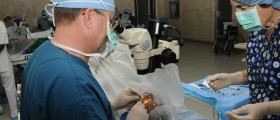
Eye transplant is a term that actually refers to corneal transplant. This surgical procedure includes transplantation of the cornea from a cadaver to a person whose cornea is severely damaged. It is not correct to say eye transplant since this may mislead people and they might think that the entire eyeball is transplanted. This is why corneal transplant is the best possible term for the procedure. It may sound amazing but in the United States over 40,000 corneal transplants are performed each year. This surgical procedure can be done in patients of all age.
Why is Corneal Transplant Done?
The cornea is part of the eye. Once it gets seriously damaged it is not capable of regenerating completely and becomes swollen, cloudy, scarred and completely nonfunctional. The damage of the cornea can be caused by a variety of conditions and injuries of the eye. The only way to restore the eyesight in this case is to replace the damaged cornea with a healthy one. Since living people simply cannot donate their cornea (they also need this organ for themselves) the organ is obtained from a deceased donor.
Corneal Transplant - the Very Procedure
The corneal transplant procedure is done under local anesthesia. The operated area is numbed and this is achieved by certain medications that are directly injected into the eye. The surgeon makes a small, circular incision in the cornea of the eye with a small, sharp instrument called trephine. A trephine looks like a cookie cutter. The cornea of the exact shape and size is cut from the donor's eye and placed onto the gap in the cornea of the recipient. And finally, the surgeon sews the transplant to the recipient's eye.
After the Surgery
Corneal transplant surgery lasts approximately 30 to 90 minutes. After the operation the eye is covered with an eye patch which is supposed to be worn the first night after the surgery. Patients are due to wear an eye shield or glasses until the wound completely heals. Prevention against infection is successfully achieved by antibiotics. They are administered in a form of eye drops. Furthermore, steroid eye drops control inflammation and prevent transplant rejection and cycloplegic eye drops keep the inner eye muscles relaxed. Painkillers may be needed one or two days after the procedure.
Risks and Complications of Corneal Transplant Surgery
Corneal transplant surgery carries several risks such as infection, cataract, glaucoma, retinal detachment etc. Even transplant rejection is possible. The results basically depend on the condition which has caused the former damage to the cornea. But what needs to be mentioned is that this is the transplant surgery with the highest success rate.

















Your thoughts on this
Loading...